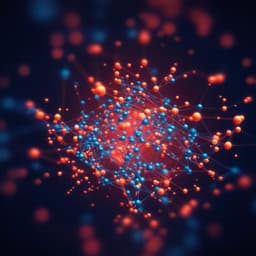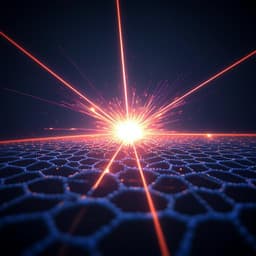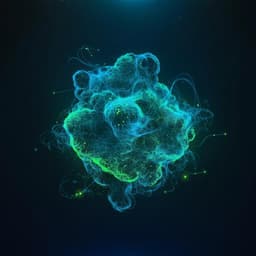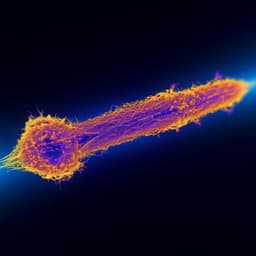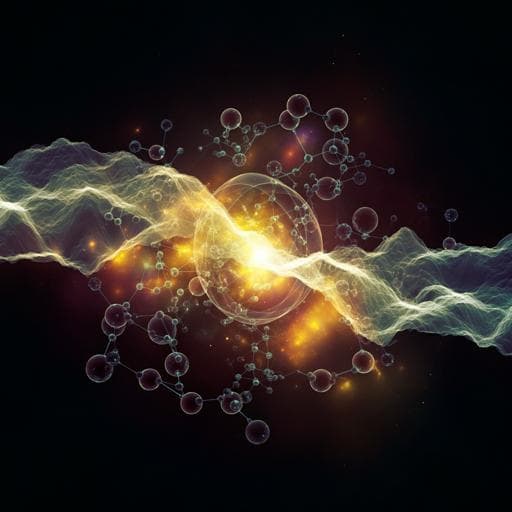
Engineering and Technology
Imaging atomic-scale chemistry from fused multi-modal electron microscopy
J. Schwartz, Z. W. Di, et al.
Discover how fused multi-modal electron microscopy transforms the mapping of atomic-scale chemistry at remarkably low doses. This innovative approach, developed by a team of researchers including Jonathan Schwartz and Zichao Wendy Di, significantly enhances the ability to image chemical distributions in nanomaterials with unparalleled precision and reduced dose requirements.
~3 min • Beginner • English
Introduction
The study addresses the challenge of high-dose requirements and noise in atomic-scale chemical imaging using STEM spectroscopies (EELS/EDX). High-resolution chemical maps typically require doses >10^6 e/Å^2, often exceeding specimen limits, leading to noisy or missing chemical information. While HAADF imaging provides higher-SNR structural information via elastic scattering, it under-describes chemistry. The hypothesis is that fusing simultaneously acquired elastic (HAADF) and inelastic (EELS/EDX) signals can recover accurate chemical maps at substantially lower doses by exploiting shared information between modalities. The purpose is to formulate and demonstrate a model-driven data fusion method that improves SNR, reduces dose, and enables stoichiometric quantification without requiring explicit inelastic cross-sections, thereby advancing low-dose chemical imaging for nanomaterials.
Literature Review
Conventional analysis treats HAADF and EELS/EDX signals separately, missing shared information. Detector improvements have pushed sensitivity but are constrained by inelastic interaction limits. Data fusion, widely used in satellite imaging, links modalities via models to reconstruct improved information and measurement accuracy. The approach leverages principles from compressed sensing and total variation regularization to reduce noise while preserving features. Prior works outline HAADF Z^γ contrast behavior (γ ≈ 1.7, bounded between ~4/3 and 2) and statistical treatments appropriate for Poisson-dominated spectroscopic data. The manuscript positions multi-modal fusion as a principled extension of correlative imaging to overcome dose/SNR limitations in STEM chemical mapping.
Methodology
The method formulates fused multi-modal recovery as a constrained optimization problem linking HAADF and spectroscopic (EELS/EDX) data with spatial regularization. The objective (Eq. (1)) minimizes: (i) a model term relating HAADF to a weighted sum of elemental distributions x with HAADF intensity scaling approximately with Z^γ (γ ∈ [1.4, 2], typically ≈1.7); (ii) a data fidelity term using maximum negative log-likelihood appropriate for Poisson-distributed spectroscopic counts (reducible to least squares at higher counts); and (iii) channel-wise total variation (TV) to promote sparse gradients, reducing noise while preserving edges. Non-negativity constraints are imposed on concentrations. Regularization weights λ1, λ2 balance contributions of model, fidelity, and TV.
Implementation: The multi-element variables are concatenated and solved via iterative gradient descent on the smooth terms (model and Poisson log-likelihood), followed by the isotropic TV proximal operator for denoising. Initialization uses measured chemical maps. Step sizes are guided by Lipschitz estimates for the model term (1/L ≲ 1/n); the Poisson term’s step size is set heuristically since its gradient is not Lipschitz. Hyperparameters are tuned to achieve stable convergence; convergence behavior of individual cost components is monitored.
Uncertainty estimation: Using estimation theory, the Hessian of the model and Poisson terms provides a Fisher Information-based Cramér–Rao lower bound for the variance at each pixel. Standard error maps are computed as the square root of the variance (diagonal of the inverse Hessian), and their spatial average serves as a scalar uncertainty metric. TV may introduce bias via smoothing, so this provides an upper bound on uncertainty.
Experimental data: Simultaneous EELS+HAADF acquired on a Nion UltraSTEM at 100 keV (probe semi-angle ~30 mrad; HAADF 80–240 mrad; EELS 0–60 mrad); beam currents ~30 pA; dwell times 10–15 ms; doses ~3.25×10^4 to 7.39×10^6 e/Å^2. EELS edges integrated after power-law background subtraction (Cornell Spectrum Imager). EDX+HAADF acquired on a Thermo Fisher Titan Themis G2 at 200 keV (probe ~25 mrad; HAADF 73–200 mrad; EDX 0.7 sr); CoS imaged at 100 pA, 40 µs dwell, 50 frames, total dose ~2×10^5 e/Å^2.
Simulations: Inelastic multislice STEM-EELS simulations for FePt nanoparticles performed with abTEM using PRISM/Scattering matrix methods. Inelastic transition potentials (Fe L2,3; Pt M4,5) from DFT (GPAW). Parameters: 200 kV, convergence 20 mrad, slice thickness 2 Å, sampling 0.15 Å, EELS detector 30 mrad, probe step 0.31 Å; images convolved with 0.2 Å Gaussian for source size. Computations required ~4000 core-hours; PRISM STEM-EELS provided >10× speedup.
Key Findings
- Fused multi-modal electron microscopy substantially improves chemical map SNR (often ~300–500% improvement) and enables dose reductions by more than an order of magnitude while remaining consistent with measurements.
- Nanoscale EDX of CoS catalysts: Multi-modal reconstructions largely eliminate shot noise and preserve resolution, revealing core–shell structures. Quantified relative concentrations: core 39 ± 1.6% Co, 42 ± 2.5% S, 13 ± 2.4% O; shell 26 ± 2.8% Co, 11 ± 2.0% S, 54 ± 1.3% O at ~10^5 e/Å^2 dose; consistent at ~10^4 e/Å^2.
- Atomic-scale EELS of Co3xMnO4 supercapacitor nanoparticles: Fusion clarifies an Mn-rich core with Co-rich crystalline shell; oxygen shows limited HAADF contrast and benefits mainly from regularization.
- Atomically sharp ZnS–Cu0.64S0.36 interface: Fusion maps an atomically abrupt interface and step edges; relative concentrations consistent with growth conditions, including 48 ± 5.9% Zn, 59.9 ± 3.2% Cu, and 38 ± 2.6% S in the Cu0.64S0.36 layer and ~48.9 ± 6% in ZnS; cost terms show smooth, asymptotic convergence.
- FePt nanoparticle simulations: With Poisson noise (SNR ≈ 5), fusion recovers elemental distributions that closely match ground truth; line profiles show near-identical atom column positions and relative intensities; peak-SNR (PSNR) increases quantify SNR gain.
- Stoichiometry without cross-sections: Relative concentration from reconstructed pixel intensities yields stoichiometrically meaningful maps. Experimental thin films: NiO recovered ~50 ± 2.9% Ni (expected 50%); ZrO2 recovered ~35 ± 5.8% Zr (expected ~33%). Synthetic Ga2O3: recovered Ga centered at 40 ± 0.4% (ground truth 40%). Overall stoichiometric error estimated <15% (±7% pixel variability combined in quadrature with ±6% hyperparameter sensitivity).
- Dose/SNR dependence: RMSE maps across HAADF and spectroscopic SNRs show accurate recovery for HAADF SNR ≥ 4 and chemical SNR ≥ 2, with continuous degradation at extremely low SNR. Average standard error correlates with RMSE (R^2 ≈ 0.66), providing an experimental proxy for accuracy.
Discussion
The findings demonstrate that linking elastic (HAADF) and inelastic (EELS/EDX) modalities within a principled optimization framework effectively recovers accurate, high-SNR chemical maps at significantly reduced doses, addressing the core challenge of dose limitations in atomic-scale chemical imaging. Fusion leverages HAADF’s structural information and spectroscopic specificity, with Poisson-consistent fidelity and TV regularization balancing noise suppression and edge preservation. The approach enables stoichiometric quantification without explicit inelastic cross-sections and provides convergence and uncertainty metrics. Practical considerations include appropriate preprocessing (background subtraction, handling overlapping X-ray lines), careful tuning of step sizes and regularization weights, and monitoring convergence. The method has reduced benefit for elements contributing negligible HAADF contrast (e.g., light elements adjacent to heavy atoms) and may require complementary elastic imaging (e.g., ABF) in such cases. At atomic resolution, occasional spurious atom artifacts can be mitigated by filtering below the first Bragg peak or initializing from lower-resolution reconstructions. The correlation between estimated standard error and RMSE suggests a viable pathway to assess reconstruction reliability when ground truth is unavailable.
Conclusion
A model-driven data fusion algorithm for STEM that combines HAADF with EELS/EDX substantially enhances spectroscopic map quality from nanometer down to atomic scales, enabling low-dose chemical imaging and stoichiometric quantification with <15% error without needing inelastic cross-sections. Demonstrations on CoS catalysts, Co–Mn oxides, ZnS–Cu0.64S0.36 heterointerfaces, and FePt simulations show large SNR gains and accurate chemistry recovery, with convergence and uncertainty assessments. The approach can be generalized to additional modalities (pixel array detectors, ABF, ptychography, low-loss EELS) toward comprehensive, efficient atomic characterization. Future work includes automated hyperparameter selection (e.g., L-curve, cross-validation), integrating complementary elastic modalities to improve light-element sensitivity, exploring dose/angle regimes (e.g., smaller ADF angles), and addressing thicker specimens with stronger channeling.
Limitations
- Reduced effectiveness for elements with negligible HAADF contrast (e.g., light elements near heavy atoms); may require adding complementary elastic modes (e.g., ABF).
- Sensitivity to spectroscopic preprocessing; errors in EELS background subtraction or overlapping EDX peaks can bias fusion results.
- Hyperparameter selection (regularization weights, step sizes) affects quantitative outcomes; estimated stoichiometry variation ±6% due to hyperparameter choices even with stable convergence.
- At extremely low SNR (below HAADF SNR ~4 and chemical SNR ~2), reconstructions degrade predictably.
- Atomic-resolution reconstructions may show spurious atom artifacts; mitigation via frequency down-sampling or lower-resolution initialization is advised.
- Assumptions in the HAADF forward model (Z^γ scaling, incoherent imaging) and sample conditions (thickness, channeling) may limit accuracy in certain regimes.
Related Publications
Explore these studies to deepen your understanding of the subject.



